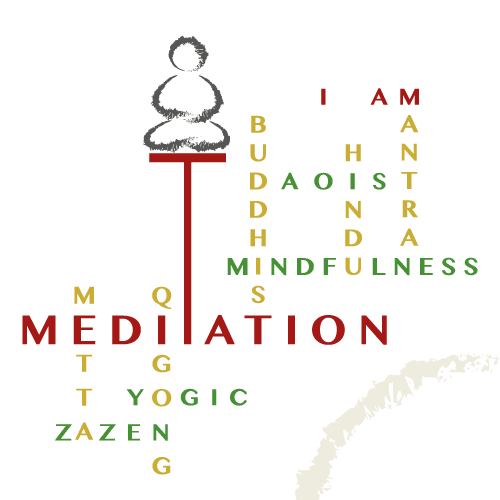Do you know that there are as many meditation strategies as there are sports activities? And the one technique to discover out one of the best forms of meditation for you is to attempt them.
As you might know, meditation has dozens of advantages, and everyone is doing it. You search for info on-line or on a bookstore, and see that there are a LOT of various types of meditation. You surprise which method is greatest for you.
It is a essential query. Several types of meditation have totally different advantages. A few of them will work higher for you than others—identical to totally different sports activities or diets work higher for some folks than for others.
There are actually a whole bunch—if not hundreds—of forms of meditation, so right here I’ll discover solely the most well-liked ones. The aim of this text is that will help you experiment totally different meditation strategies, and discover those that works greatest for you.
Discovering the best model for you, and working towards it with the best strategy, is among the three important Pillars of Meditation.
There isn’t a cookie-cutter strategy to meditation. You might want to experiment many, and discover the one which works greatest on your distinctive wants and character. The kind of meditation that’s most useful in opposition to nervousness, as an illustration, isn’t essentially one of the best one in opposition to despair or for non secular awakening.
In case you favor extra dynamic meditation strategies, take a look at my strolling meditation information.
The recommendation concerning the posture of meditation could be very comparable among the many totally different types of seated observe, so I’ll go in to extra element about it solely as soon as, when speaking concerning the first approach (Zen meditation).
I’ve strived to incorporate a “Is it for me?” part, with common observations about every observe. Take note these are tentative; they’re there to offer some path, and probably any individual might really feel drawn to any of those modalities.
This text does NOT inform you which is “one of the best” kind of meditation – as a result of there isn’t a such factor, and I’m not right here to create controversy. Additionally, I’ve right here centered extra on meditative practices; I’ll write one other article on different comparable practices, which might be extra about rest or contemplation.
In case you are a newbie, you might also benefit from the put up on meditation for learners – the way to construct the behavior.
Alternatively, in case you are searching for the historic background of how meditation developed over the centuries, take a look at my historical past of meditation article.
(This text can be obtainable in Russian, Portuguese, Romanian, Croatian and Polish. Translation carried out by LiveAndDare readers.)
Kinds of Meditation PDF
By the way in which, do you need to have a PDF model of this text, for straightforward future reference?
GENERAL TYPES OF MEDITATION
Scientists normally classify meditation based mostly on the way in which they focus consideration, into two classes: Centered Consideration and Open Monitoring. I’d wish to suggest a 3rd: Easy Presence.
Centered consideration meditation
Focusing the eye on a single object throughout the entire meditation session. This object often is the breath, a mantra, visualization, a part of the physique, exterior object, and many others. Because the practitioner advances, his capability to maintain the movement of consideration within the chosen object will get stronger, and distractions grow to be much less frequent and short-lived. Each the depth and steadiness of his consideration are developed.
Examples of those are: Samatha (Buddhist meditation), some types of Zazen, Loving Kindness Meditation, Chakra Meditation, Kundalini Meditation, Sound Meditation, Mantra Meditation, Pranayama, some types of Qigong, and plenty of others.
Open monitoring meditation
As a substitute of focusing the eye on anyone object, we preserve it open, monitoring all facets of our expertise, with out judgment or attachment. All perceptions, be them inside (ideas, emotions, reminiscence, and many others.) or exterior (sound, odor, and many others.), are acknowledged and seen for what they’re. It’s the strategy of non-reactive monitoring of the content material of expertise from second to second, with out going into them. Examples are: Mindfulness meditation, Vipassana, in addition to some forms of Taoist Meditation.
Easy Presence
It’s the state the place the eye isn’t centered on something particularly, however reposes on itself – quiet, empty, regular, and introverted. We will additionally name it “Choiceless Consciousness” or “Pure Being”. A lot of the meditation quotes you find speak of this state.
This is actually the true purpose behind all kinds of meditation, and not a meditation type in itself. All traditional techniques of meditation recognize that the object of focus, and even the process of monitoring, is just a means to train the mind, so that effortless inner silence and deeper states of consciousness can be discovered. Eventually, both the object of focus and the process itself is left behind, and there is only left the true self of the practitioner, as “pure presence”.
In some techniques, this is the only focus, from the beginning. Examples are: the Self-Enquiry (“I am” meditation) of Ramana Maharishi; Dzogchen; Mahamudra; some forms of Taoist Meditation; and some advanced forms of Raja Yoga. In my point of view, this type of meditation always requires previous training to be effective, even though this is sometimes not expressly said (only implied).
1) BUDDHIST MEDITATION TECHNIQUES
Zen Meditation (Zazen)
Origin & Meaning
Zazen (坐禅) means “seated Zen”, or “seated meditation”, in Japanese. It has its roots in the Chinese Zen Buddhism (Ch’an) tradition, tracing back to Indian monk Bodhidharma (6th century CE). In the West, its most popular forms comes from Dogen Zenji (1200~1253), the founder of Soto Zen movement in Japan. Similar modalities are practiced in the Rinzai school of Zen, in Japan and Korea.
How to do it
It is generally practiced seated on the floor over a mat and cushion, with crossed legs. Traditionally it was done in the so-called lotus or half-lotus position, but this is hardly necessary. Nowadays most practitioners sit like this:
Or on a chair:
Images courtesy of Zen Mountain Monastery
Crucial side, as you see within the photos, is protecting the again utterly straight, from the pelvis to the neck. Mouth is stored shut and eyes are stored lowered, along with your gaze resting on the bottom about two or three ft in entrance of you.
As to the thoughts side of it, it’s normally practiced in two methods:
- Specializing in breath — focus all of your consideration on the motion of the breath going out and in by means of the nostril. This can be aided by counting the breath in your thoughts. Every time you inhale you rely one quantity, beginning with 10, after which shifting backward to 9, 8, 7, and many others. While you arrive in 1, you resume from 10 once more. In case you get distracted and lose your rely, gently carry again the eye to 10 and resume from there.
- Shikantaza (“simply sitting”) — on this kind the practitioner doesn’t use any particular object of meditation; fairly, practitioners stay as a lot as doable within the current second, conscious of and observing what passes by means of their minds and round them, with out dwelling on something particularly. It’s a sort of Easy Presence meditation
Be taught extra:
Is it for me?
Zazen is a really sober meditation model, and you’ll simply discover a number of robust communities working towards it, in addition to loads of info on the web. There’s a number of emphasis in protecting the best posture, as an assist for focus. It’s normally practiced in Zen Buddhist facilities (Sangha), with robust neighborhood help.
In lots of them you’ll find it coupled with different parts of Buddhist observe: prostrations, a little bit of ritualism, chanting, and group readings of the Buddha teachings. Some folks will like this, others received’t. Personally, I practiced zazen in a Buddhist group for 3 years, and I discovered that these parts and a bit of ritual may also assist create a construction for the observe, and in themselves they’re additionally meditative.
Vipassana Meditation
Origin & Which means
“Vipassana” is a Pali phrase tha
t means “perception” or “clear seeing”. It’s a conventional Buddhist observe, relationship again to sixth century BC. Vipassana-meditation, as taught in the previous few a long time, comes from the Theravada Buddhist custom, and was popularized by S. N. Goenka and the Vipassana movement.
Because of the recognition of Vipassanā-meditation, the “mindfulness of respiration” has gained additional recognition within the West as “mindfulness”.
Learn how to do it
[There is some conflicting information on how to practice Vipassana. In general, however, most teachers emphasize starting with mindfulness of breath in the first stages, to stabilize the mind and achieve “access concentration.” This is more like focused attention meditation. Then the practice moves on to developing “clear insight” on the bodily sensations and mental phenomena, observing them moment by moment and not clinging to any. Here goes an introduction, aimed for beginners. To know more I’d suggest following up the links provided or learning from a teacher (perhaps in a Vipassana retreat).]
Ideally, one is to sit down on a cushion on the ground, cross-legged, along with your backbone erect; alternatively, a chair could also be used, however the again shouldn’t be supported.
The primary side is to develop focus, by means of samatha observe. That is sometimes carried out by means of respiration consciousness.
Focus all of your consideration, from second to second, on the motion of your breath. Discover the delicate sensations of the motion of the stomach rising and falling. Alternatively, one can deal with the feeling of the air passing by means of the nostrils and touching the higher lips pores and skin – although this requires a bit extra observe, and is extra superior.
As you deal with the breath, you’ll discover that different perceptions and sensations proceed to look: sounds, emotions within the physique, feelings, and many others. Merely discover these phenomena as they emerge within the area of consciousness, after which return to the feeling of respiration. The eye is stored within the object of focus (the respiration), whereas these different ideas or sensations are there merely as “background noise”.
The article that’s the focus of the observe (as an illustration, the motion of the stomach) known as the “main object”. And a “secondary object” is anything that arises in your area of notion – both by means of your 5 senses (sound, odor, itchiness within the physique, and many others.) or by means of the thoughts (thought, reminiscence, feeling, and many others.). If a secondary object hooks your consideration and pulls it away, or if it causes want or aversion to look, it is best to deal with the secondary object for a second or two, labeling it with a psychological word, like “pondering”, “reminiscence”, “listening to”, “needing”. This observe is commonly known as “noting”.
A psychological word identifies an object usually however not intimately. While you’re conscious of a sound, for instance, label it “listening to” as an alternative of “motorbike,” “voices” or “barking canine.” If an disagreeable sensation arises, word “ache” or “feeling” as an alternative of “knee ache” or “my again ache.” Then return your consideration to the first meditation object. When conscious of a perfume, say the psychological word “smelling” for a second or two. You don’t should determine the scent.
When one has thus gained “entry focus”, the eye is then turned to the item of observe, which is often thought or bodily sensations. One observes the objects of consciousness with out attachment, letting ideas and sensations come up and cross away of their very own accord. Psychological labeling (defined above) is commonly use as a technique to stop you from being carried away by ideas, and preserve you in additional objectively noticing them.
Consequently one develops the clear seeing that the noticed phenomena is pervaded by the three “marks of existence”: impermanence (annica), insatisfactoriness (dukkha) and vacancy of self (annata). Consequently, equanimity, peace and interior freedom is developed in relation to those inputs.
Be taught extra:
Is it for me?
Vipassana is a superb meditation that will help you floor your self in your physique, and perceive how the processes of your thoughts work. It’s a very talked-about model of meditation. Yow will discover loads of academics, web sites, and books about it, in addition to 3~10 days retreats (donation based mostly). The educating of it’s all the time free. There are not any formalities or rituals connected to the observe.
In case you are utterly new to meditation, Vipassana or Mindfulness are most likely good methods so that you can begin.
Mindfulness Meditation
Origin & Which means
Mindfulness Meditation is an adaptation from conventional Buddhist meditation practices, particularly Vipassana, but in addition having robust affect from different lineages (such because the Vietnamese Zen Buddhism from Thich Nhat Hanh). “Mindfulness” is the frequent western translation for the Buddhist time period sati. Anapanasati, “mindfulness of respiration”, is a part of the Buddhist observe of Vipassana or perception meditation, and different Buddhist meditational practices, comparable to zazen (supply: Wikipedia).
One of many fundamental influencers for Mindfulness within the West is John Kabat-Zinn. His Mindfulness-Based mostly Stress Discount program (MBSR) – which he developed in 1979 on the College of Massachusetts Medical Faculty – has been utilized in a number of hospitals and well being clinic on the previous a long time.
Learn how to do it
Mindfulness meditation is the observe of deliberately specializing in the current second, accepting and non-judgmentally taking note of the sensations, ideas, and feelings that come up.
For the “formal observe” time, sit on a cushion on the ground, or on a chair, with straight and unsupported again. Pay shut consideration to the motion of your breath. While you breath in, remember that you’re inhaling, and the way it feels. While you breath out, remember you’re respiration out. Do like this for the size of your meditation observe, consistently redirecting the eye to the breath. Or you’ll be able to transfer on to be taking note of the sensations, ideas and emotions that come up.
The hassle is to not deliberately add something to our current second expertise, however to concentrate on what’s going on, with out dropping ourselves in something that arises.
Your thoughts will get distracted into going together with sounds, sensations, and ideas. At any time when that occurs, gently acknowledge that you’ve been distracted, and produce the eye again to the respiration, or to the target noticing of that thought or sensation. There’s a large totally different between being inside the thought/sensation, and easily being conscious of it’s presence.
Be taught to get pleasure from your observe. As soon as you’re carried out, recognize how totally different the physique and thoughts really feel.
There’s additionally the observe of mindfulness throughout our each day actions: whereas consuming, strolling, and speaking. For “each day life” meditation, the observe is to concentrate to what’s going on within the current second, to concentrate on what is going on – and never residing in “automated mode”. In case you are talking, which means taking note of the phrases you communicate, the way you communicate them, and to pay attention with presence and a spotlight. In case you are strolling, which means being extra conscious of your physique actions, your ft touching the bottom, the sounds you’re listening to, and many others.
Your effort in seated observe helps your each day life observe, and vice-versa. They’re each equally vital.
Be taught extra:
Is it for me?
For most people, that is maybe probably the most advisable technique to get began with meditation. It’s the kind of meditation that’s most taught at colleges and hospitals, so far as I’m conscious. The “mindfulness motion” as practiced these days in society at giant, isn’t Buddhism, however an adaptation of Buddhist practices as a consequence of their advantages in good bodily and psychological well being and common wellbeing.
For most individuals, Mindfulness Meditation often is the solely kind of meditation they are going to like, particularly if their focus is barely the bodily and psychological advantages of meditation, as it’s normally taught dissociated from a number of of the japanese ideas and philosophies that historically accompanied the observe. And for that it’s nice – it would carry many good issues to your life.
In case your focus is a deeper transformation and non secular growth, nevertheless, then mindfulness meditation could also be simply an preliminary step for you. From right here you’ll be able to then transfer into Vipassana, Zazen, or different forms of meditation.
Loving Kindness Meditation (Metta Meditation)
Origin & Which means
Metta is a Pali phrase which means kindness, benevolence, and good will. This observe comes from the Buddhist traditions, particularly the Theravada and Tibetan lineages. “Compassion meditation” is a up to date scientific area that demonstrates the efficacy of metta and associated meditative practices.
Demonstrated advantages embrace: boosting one’s capability to empathize with others; growth of optimistic feelings by means of compassion, together with a extra loving angle in direction of oneself; elevated self-acceptance; larger feeling of competence about one’s life; and elevated feeling of goal in life (learn extra in our different put up).
Learn how to do it
One sits down in a meditation place, with closed eyes, and generates in his thoughts and coronary heart emotions of kindness and benevolence. Begin by growing loving-kindness in direction of your self, then progressively in direction of others and all beings. Normally this development is suggested:
- oneself
- buddy
- a “impartial” individual
- a tough individual
- all 4 of the above equally
- after which regularly your complete universe
The sensation to be developed is that of wishing happiness and well-being for all. This observe could also be aided by reciting particular phrases or sentences that evoke the “boundless warm-hearted feeling”, visualizing the struggling of others and sending love; or by imagining the state of one other being, and wishing him happiness and peace.
The extra you observe this meditation, the extra pleasure you’ll expertise. That’s the secret of Mathieu Richard’s happiness.
“For one who attends correctly to the liberation of the guts by benevolence, unarisen ailing will doesn’t come up and arisen ailing will is deserted.” – The Buddha
In this article, Emma Seppälä, Ph.D explores the 18 scientifically confirmed advantages of Loving-Kindness meditation.
Be taught extra:
Is it for me?
Are you generally too exhausting on your self or on others? Or really feel like you’ll want to enhance your relationships? Loving-kindness meditation will allow you to. It’s useful each for selfless and self-centered folks, and it’ll assist enhance your common degree of happiness. You can’t really feel loving-kindness and despair (or some other adverse feeling) on the similar time.
Additionally it is usually beneficial, by Buddhist academics, as an antidote to insomnia, nightmares, or anger points.
2) HINDU MEDITATION TECHNIQUES (Vedic & Yogic)
Mantra Meditation (OM Meditation)
Origin & Which means
A mantra is a syllable or phrase, normally with none specific which means, that’s repeated for the aim of focusing your thoughts. It’s not an affirmation used to persuade your self of one thing.
Some meditation academics insist that each the selection of phrase, and its right pronunciation, is essential, as a result of “vibration” related to the sound and which means, and that because of this an initiation into it’s important. Others say that the mantra itself is barely a device to focus the thoughts, and the chosen phrase is totally irrelevant.
Mantras are utilized in Hindu traditions, Buddhist traditions (particularly Tibetan and “Pure Land” Buddhism), as effectively as in Jainism, Sikhism and Daoism (Taoism). Some folks name mantra meditation “om meditation”, however that’s simply one of many mantras that can be utilized. A extra devotion oriented observe of mantras known as japa, and consists of repeating sacred sounds (title of God) with love.
Learn how to do it
As most kind of meditations, it’s normally practiced sitting with backbone erect, and eyes closed. The practitioner then repeats the mantra in his thoughts, silently, again and again throughout the entire session.
Typically this observe is coupled with being conscious of the respiration or coordinating with it. In different workouts, the mantra is definitely whispered very flippantly and softly, as an assist to focus.
As you repeat the mantra, it creates a psychological vibration that enables the thoughts to expertise deeper ranges of consciousness. As you meditate, the mantra turns into more and more summary and vague, till you’re lastly led into the sector of pure consciousness from which the vibration arose.
Repetition of the mantra helps you disconnect from the ideas filling your thoughts in order that maybe you might slip into the hole between ideas. The mantra is a device to help your meditation observe. Mantras might be seen as historical energy phrases with delicate intentions that assist us connect with spirit, the supply of every little thing within the universe. (Deepak Chopra)
OM is a well known instance of a mantra. However there are thousadns of others. Listed below are among the most well-known mantras from the Hindu & Buddhist traditions:
- om
- so-ham
- om namah shivaya
- om mani padme hum
- rama
- yam
- ham
Chances are you’ll observe for a sure time period, or for a set variety of “repetitions” – historically 108 or 1008. Within the latter case, beads are sometimes used for protecting rely.
Because the observe deepens, you might discover that the mantra continues “by itself” just like the buzzing of the thoughts. Or the mantra could even disappear, and you’re left in a state of deep interior peace.
There are a lot of strategies of mantra meditation. I clarify them intimately, along with why mantras are highly effective, on my article on mantra meditation.
Be taught extra:
Is it for me?
Folks normally discover that it’s simpler to focus with a mantra than with the respiration. As a result of a mantra is a phrase, and ideas are normally perceived as phrases, it may be simpler to maintain the deal with a mantra fairly than on the respiration. It’s helpful particularly when the thoughts is racing with many ideas, because it mantra meditation calls for fixed consideration.
Meditating with a mantra may also make it less complicated to combine your meditative state into your each day life. In no matter exercise you end up into, it may be so simple as repeating the mantra in your thoughts.
Transcendental Meditation (TM)
Origin & Which means
Transcendental Meditation is a selected type of Mantra Meditation launched by Maharishi Mahesh Yogi in 1955 in India and the West. Within the late Sixties and early Nineteen Seventies, the Maharishi achieved fame because the guru to the Beatles, The Seashore Boys and other celebrities.
It’s a extensively practiced type of meditation, with over 5 million practitioners worldwide, and there’s a number of scientific analysis, many sponsored by the group, demonstrating the advantages of the observe. There are over 600 scientific papers, lots of them peer-reviewed, and I’ve used a part of their analysis when composing my advantages of meditation web page. Nonetheless, there are additionally critics of the Maharishi and his group, and a few accusation of cultish conduct and uncertain analysis practices.
[Image from NurseTalkSite.com]
Learn how to do it
Transcendental meditation isn’t taught freely. The one method of studying it’s to pay to be taught from one in all their licensed instructors. The help given appears to be good, although.
Typically, nevertheless, it’s recognized that TM includes using a mantra and is practiced for 15–20 minutes twice per day whereas sitting with one’s eyes closed. The mantra isn’t distinctive, and is given to the practitioner based mostly on his gender and age. They’re additionally not “meaningless sounds” – fairly, they’re Tantric names of Hindu deities. This most likely is irrelevant for most individuals.
That is the official web site of the motion: TM site.
Learn how to be taught transcendental meditation by your self?
It isn’t doable. Based on the TM group, you’ll be able to solely be taught Transcendental Meditation by a registered teacer.
Nonetheless, there’s one other comparable approach, known as Pure Stress Reduction, which was created in 2003 by a former TM Instructor, and is less expensive to be taught (47 USD as an alternative of 960 USD), and has stripped out some mystical parts of the observe of TM, such because the initiation (puja) and yogic flying (a part of TM-Siddhi). You’ll be able to be taught extra about NSR compared to TM here and here.
Is it for me?
Personally I don’t really feel comfy advising anybody to attempt Transcendental Meditation anymore, particularly in case you are seeking to go deep into meditation. To know extra, take a look at this answer I wrote in Quora and this in-depth video review.
In case you want to attempt one thing comparable, for a fraction of the fee or totally free, take a look at NSR (above), or Mantra Meditation.
Yogic Meditations
Origin & Which means
There’s not one kind of meditation which is “Yogic Meditation”, so right here it’s meant the a number of meditation sorts taught within the yoga custom. Yoga means “union”. Custom goes so far as 1700 B.C, and has as its highest aim non secular purification and Self-Data. Classical Yoga divides the observe into guidelines of conduct (yamas and niyamas), bodily postures (asanas), respiration workouts (pranayama), and contemplative practices of meditation (pratyahara, dharana, dhyana, samadhi).
The Yoga custom is the oldest meditation custom on earth, and in addition the one with the widest number of practices.
Learn how to do it
Listed below are some forms of meditation practiced in Yoga. The most typical and common Yoga meditation one is the “third eye meditation”. Different widespread ones contain concentrating on a chakra, repeating a mantra, visualization of sunshine, or gazing meditations.
- Third Eye Meditation — focusing the eye on the “spot between the eyebrows” (known as by some “the third eye” or “ajna chakra”). The eye is continually redirected so far, as a method to silence the thoughts. By time the “silent gaps” between ideas get wider and deeper. Typically that is accompanied by bodily “wanting”, with eyes closed, in direction of that spot.
- Chakra Meditation — the practitioner focuses on one of many seven chakras of the physique (“facilities of power”), sometimes performing some visualizations and chanting a selected mantra for every chakra (lam, vam, ram, yam, ham, om). Mostly it’s carried out on the guts chackra, third eye, and crown chackra.
- Gazing Meditation (Trataka) — fixing the gaze on an exterior object, sometimes a candle, picture or a logo (yantras). It’s carried out with eyes open, after which with eyes closed, to coach each the focus and visualization powers of the thoughts. After closing the eyes, it is best to nonetheless preserve the picture of the item in your “thoughts’s eye”. This meditation is so vital and highly effective, that I wrote this put up on the topic.
- Kundalini Meditation — it is a very complex system of observe. The aim is the awakening of the “kundalini power” which lies dormant on the bottom of the backbone, the event of a number of psychic facilities within the physique, and, lastly, enlightenment. There are a number of risks related to this observe, and it shouldn’t be tried with out the steerage of a certified yogi.
- Kriya Yoga — is a set of energization, respiration, and meditation workouts taught by Paramahamsa Yogananda. That is extra suited for many who have a devotional temperament, and are searching for the non secular facets of meditation. To be taught it, you’ll be able to apply to obtain the Self-Realization classes, free of charge.
- Sound Meditation (Nada Yoga) — specializing in sound. Begins with meditation on “exterior sounds”, comparable to calming ambient music (like Native American flute music), whereby the coed focuses all his consideration on simply listening to, as a assist to quieten and acquire the thoughts. By time the observe evolves to listening to the “inside sounds” of the physique and thoughts. The last word aim is to listen to the “Final Sound” (para nada), which is a sound with out vibration, and that manifests as “OM”.
- Tantra — not like the favored view within the West, most Tantra practices don’t have anything to do with ritualized intercourse (this was practiced by a minority of lineages. Tantra is a really wealthy custom, with dozens of various contemplative practices. The textual content Vijnanabhairava Tantra, as an illustration, lists 108 “meditations”, most of them extra superior (already requiring a sure diploma of stillness and thoughts management). Listed below are some examples from that textual content:
- Merge the thoughts and the senses within the inside house within the non secular coronary heart.
- When one object is perceived, all different objects grow to be empty. Focus on that vacancy.
- Focus on the house which happens between two ideas.
- Repair consideration on the within of the cranium. Shut eyes.
- Meditate on the event of any nice delight.
- Meditate on the sensation of ache.
- Dwell on the truth which exists between ache and pleasure.
- Meditate on the void in a single’s physique extending in all instructions concurrently.
- Focus on a bottomless effectively or as standing in a really excessive place.
- Take heed to the Anahata [heart chakra] sound.
- Take heed to the sound of a musical instrument because it dies away.
- Ponder on the universe or one’s personal physique as being full of bliss.
- Focus intensely on the concept that the universe is totally void.
- Ponder that the identical consciousness exists in all our bodies.
- Pranayama — respiration regulation. It isn’t precisely meditation, however a wonderful observe to calm the thoughts and put together it for meditation. There are a number of several types of Pranayama, however the easiest and mostly taught one is the 4-4-4-4. This implies inhaling counting as much as 4, holding for 4 seconds, respiration out for 4 seconds, and holding empty for 4 seconds. Breathe by means of your nostril, and let the stomach (and never the chest) be the one which strikes. Undergo a number of cycles like this. This regulation of respiration balances the moods and pacifies the physique, and might be carried out wherever.
Yoga is a really wealthy custom, with totally different lineages, so there are a lot of different strategies. However the ones above are probably the most well-known; the others are extra particular or complicated.
For a begin, this video is a superb useful resource on the way to do Yoga model meditation, and it combines respiration, physique consciousness, mantra, and chakra meditation.
Be taught extra:
Is it for me?
With all a majority of these meditation in Yoga, you’re more likely to discover one that you simply like. In case you are a musician, maybe nada yoga is one thing that can appeal to you. In case you are a devotional individual, kriya yoga is an efficient choice. Kundalini and Chakra meditation ought to solely be tried with a instructor.
Most likely the only one to attempt is the “third eye meditation”, which is easy and yields outcomes pretty shortly. For the opposite sorts you’ll most likely want extra instruction, both of a instructor or guide (see references above). In addition to, Pranayama is certainly one thing anybody can profit from.
Self-Enquiry and “I Am” Meditation
Origin & Which means
Self-Enquiry is the English translation for the Sanskrit time period atma vichara. It means to “examine” our true nature, to search out the reply to the “Who am I?” query, which culminates with the intimate data of our true Self, our true being. We see references to this meditation in very outdated Indian texts; nevertheless, it was tremendously popularized and expanded upon by the Twentieth-century Indian sage Ramana Maharshi (1879~1950).
The trendy non-duality motion (or neo-advaita), which is tremendously impressed in his teachings – in addition to these of Nisargadatta Maharaj (1897~1981) and Papaji – strongly makes use of this system and variations. Many modern academics to make use of this system, probably the most well-known ones being Mooji (whom I’ve personally been with and suggest), Adyashanti, and Eckhart Tolle.
Learn how to do it
This observe could be very easy, but in addition very delicate. When explaining it, nevertheless, it might sound very summary.
Your sense of “I” (or “ego”) is the middle of your universe. It’s there, in some kind or one other, behind all of your ideas, feelings, recollections, and perceptions. But we’re not clear about what this “I” is – about who we actually are, in essence – and confuse it with our physique, our thoughts, our roles, our labels. It’s the largest thriller in our lives.
With Self-Enquiry, the query “Who I’m?” is requested inside your self. You have to reject any verbal solutions that will come, and use this query merely as a device to repair your consideration within the subjective feeling of “I” or “I’m”. Develop into one with it, go deep into it. It will then reveal your true “I”, your actual self as pure consciousness, past all limitation. It isn’t an mental pursuit, however a query to carry the eye to the core ingredient of your notion and expertise: the “I”. This isn’t your character, however a pure, subjective, feeling of current – with none photos or ideas connected to it.
At any time when ideas/emotions come up, you ask your self, “To whom does this come up?” or “Who’s conscious of _____ (anger, concern, ache, or no matter)?” The reply shall be “It’s me!”. From then you definitely ask “Who am I?”, to carry the eye again to the subjective feeling of self, of presence. It’s pure existence, objectless and choice-less consciousness.
One other method of explaining this observe is to simply focus the thoughts in your feeling of being, the non-verbal “I’m” that shines inside you. Preserve it pure, with out affiliation with something you understand.
With all different forms of meditation, the “I” (your self) is specializing in some object, inside or exterior, bodily or psychological. In self-enquiry, the “I” is specializing in itself, the topic. It’s the consideration turned in direction of its supply.
There isn’t a particular place to observe, though the final ideas about posture and atmosphere are useful for learners.
Be taught extra:
Is it for me?
This meditation could be very highly effective in bringing interior freedom and peace; but, in case you don’t have earlier expertise with meditation, you might discover it very exhausting to observe by means of. As an preliminary assist to offer you a sense for it, I might advise following some guided meditations from Mooji, in YouTube.
3) CHINESE MEDITATION TECHNIQUES
Taoist Meditations
Origin & Which means
Daoism is a Chinese language philosophy and religion, relationship again to Lao Tzu (or Laozi). It emphasizes residing in concord with Nature, or Tao, and it’s fundamental textual content is the Tao Te Ching, relationship again to sixth century B.C. In a while some lineages of Taoism have been additionally influenced by Buddhist meditation practices introduced from India, particularly on the eighth century C.E..
The chief attribute of this sort of meditation is the era, transformation, and circulation of interior power. The aim is to quieten the physique and thoughts, unify physique and spirit, discover interior peace, and harmonize with the Tao. Some types of Taoist Meditation are particularly centered on enhancing well being and giving longevity.
Picture from InternalArtsInternational.com
Learn how to do it
There are a number of several types of Taoist meditation, and they’re generally labeled in three: “perception”, “concentrative”, and “visualization”. Here’s a temporary overview:
- Vacancy meditation (Zuowang)— to sit down quietly and empty oneself of all psychological photos (ideas, emotions, and so forth), to “neglect about every little thing”, as a way to expertise interior quiet and vacancy. On this state, important pressure and “spirit” is collected and replenished. That is much like the Confucius self-discipline of “heart-mind fasting”, and it’s thought to be “the pure method”. One merely permits all ideas and sensations come up and fall by themselves, with out partaking with or “following” any of them. If that is discovered to be too exhausting and “uninteresting”, the coed is instructed with different forms of meditation, comparable to visualization and Qigong
- Visualization (Cunxiang) — an esoteric observe of visualizing totally different facets of the cosmos in relation to 1’s personal physique and self.
- Respiratory meditation (Zhuanqi) — to deal with the breath, or “unite thoughts and qi”. The instruction is “focus your important breath till it’s supremely gentle”. Typically that is carried out by merely quietly observing the breath (much like Mindfulness Meditation in Buddhism); in different traditions it’s by following sure patterns of exhalation and inhalation, in order that one turns into straight conscious of the “dynamisms of Heaven and Earth” by means of ascending and descending breath (a sort of Qigong, much like Pranayama in Yoga).
- Interior Imaginative and prescient (Neiguan) — visualizing inside one’s physique and thoughts, together with the organs, “interior deities”, qi (important pressure) actions, and thought processes. It’s a strategy of acquainting oneself with the knowledge of nature in your physique. There are specific directions for following this observe, and guide or a instructor is required.
- Inner Alchemy (Neidan) — a fancy and esoteric observe of self-transformation using visualization, respiration workouts, motion and focus. Some Qigong workouts are simplified types of inside alchemy practices.
Most of those meditations are carried out seated cross-legged on the ground, with backbone erect. The eyes are stored half-closed and stuck on the purpose of the nostril.
Grasp Liu Sichuan emphasises that, though not straightforward, ideally one ought to observe by “becoming a member of the breath and the thoughts collectively”; for those who discover this too exhausting, he would suggest specializing in the decrease stomach (dantian).
Be taught extra:
Is it for me?
Folks which might be extra linked with the physique and nature could wish to attempt Taoist meditation, and revel in studying a bit concerning the philosophy behind it. Or in case you are into martial arts or Tai Chi, this could be of your curiosity. Nonetheless, Taoist facilities and academics usually are not as straightforward to search out as Buddhist and Yoga ones, so it could be a problem to observe by means of.
Qigong (Chi kung)
Origin & Which means
Qigong (additionally spelled chi kung, or chi gung) is a Chinese language phrase which means “life power cultivation”, and is a body-mind train for well being, meditation, and martial arts coaching. It sometimes includes sluggish physique motion, interior focus, and controlled respiration. Historically it was practiced and taught in secrecy within the Chinese language Buddhist, Taoist and Confucianist traditions. Within the Twentieth century, Qigong motion has integrated and popularized Daoist meditation, and “primarily employs concentrative workouts but in addition favors the circulation of power in an inner-alchemical mode” (Kohn 2008a:120).
For a deep examine on Qigong historical past, concept, and philosophy, I like to recommend The Root of Chinese Qigong.
Daoist practices might also make use of Qigong, however since Qigong can be utilized in different Chinese language philosophies, I made a decision to deal with it as a separate topic.
Learn how to do it
There are literally thousands of totally different Qigong workouts cataloged, involving over 80 several types of respiration. Some are particular to martial arts (to energise and strengthen the physique); others are for well being (to nourish physique capabilities or treatment illnesses); and others for meditation and non secular cultivation. Qigong might be practiced in a static place (seated or standing), or by means of a dynamic set of actions – which is what you sometimes see in YouTube movies and on DVDs. The workouts which might be carried out as a meditation, nevertheless, are usually carried out sitting down, and with out motion.
To grasp extra about Qigong and learn to do it, I’d suggest getting a guide or DVD set from Dr. Yang Jwing Ming, comparable to this one. However right here goes an introductory overview of the observe of seated Qigong meditation:
- Sit in a cushty place. Ensure your physique is balanced and centered.
- Chill out your complete physique – muscle tissues, nerves, and inside organs
- Regulate your respiration, making it deep, lengthy, and gentle.
- Calm your thoughts
- Place all of your consideration within the “decrease dantien”, which is the middle of gravity of the physique, two inches under the navel. It will assist accumulate and root the qi (important power). The place your thoughts and intention is, there shall be your qi. So, by specializing in the dantien, you’re gathering power on this pure reservoir.
- Really feel the qi circulating freely by means of your physique.
Different well-known Qigong workouts are:
- Small Circulation (additionally known as “microcosmic circulation”)
- Embryonic Respiratory
- Eight Items of Brocade (see this book excerpt & Wikipedia article)
- Muscle Tendon Altering (or “Yi Jin Jing”, taught by Bodhidharma)
The primary two are seated meditation, whereas the latter two are dynamic Qigong, integrating physique stretches.
Be taught extra:
Is it for me?
Qigong meditation could also be extra enticing to people who wish to combine a extra lively physique and power work into the observe. If seated meditation is insufferable for you, and you like one thing a bit extra lively, attempt among the extra dynamic types of Qigong. Once more, there are a number of types of Qigong on the market, and you might have to attempt with totally different academics or DVDs to search out the one which fits you.
Some folks have a style of dynamic Qigong by means of the observe of Tai Chi.
4) CHRISTIAN MEDITATION
In Japanese traditions (Hinduism, Buddhism, Jainism, Daoism) meditation is normally practiced with the aim of transcending the thoughts and attaining enlightenment. Alternatively, within the Christian custom the aim of contemplative practices is, one could say, ethical purification and deeper understanding of the Bible; or a more in-depth intimacy with God/Christ, for the extra mystic stream of the custom.
Listed below are some types of Christian contemplative observe:
- contemplative prayer — which normally includes the silent repetition of sacred phrases or sentences, with focus and devotion
- contemplative studying — or just “contemplation”, which includes pondering deeply concerning the teachings and occasions within the Bible.
- “sitting with God” — a silent meditation, normally preceded by contemplation or studying, wherein we focus all our thoughts, coronary heart and soul on the presence of God
To learn extra about this, take a look at our put up on Contemplative Prayer and Christian Meditation.
5) SUFI MEDITATION TECHNIQUES
Sufism is the esoteric path inside Islam, the place the aim is to purify oneself and obtain mystical union with the Supreme (named Allah on this custom). The practitioners of Sufism are known as Sufis, they usually observe a wide range of non secular practices, lots of which have been influenced by the custom of Yoga in India.
Their fundamental strategies embrace:
- Contemplation of God (muraqabah)
- Sufi Mantra meditation (zikr, jikr or dhikr)
- Heartbeat meditation
- Sufi respiration meditation (together with 5 Parts Respiratory)
- Bond of Love meditation
- Gazing meditation
- Sufi strolling meditation
- Sufi whirling
Take a look at this text for a full exploration of Sufi Meditation.
6) GUIDED MEDITATIONS
Origin & Which means
Guided Meditation is, in nice half, a contemporary phenomenon. It’s a better technique to begin, and you’ll find guided meditations based mostly on a number of of the above traditions.
The observe of meditation requires some dose of willpower and will-power. Up to now, people who have been into meditation have been extra dedicated to it, and in addition had robust beliefs fuelling their motivation. Their life was extra easy, with much less distractions.
We dwell in very totally different occasions now. Our life is busier. Distractions are in every single place, and meditation is commonly sought as a method to develop higher well being, improve efficiency, or enhance oneself.
For these causes, guided meditations are very helpful. They’re each an incredible assist in introducing you to the observe, allow you to experiment totally different strategies, or preserve your consideration extra current within the meditation.
[Image from BinauralBeatsMeditation.com]
Learn how to do it
Guided meditation normally comes within the type of audio (file, podcast, CD), and generally audio and video. You can see that any guided meditation will fall in one in all under classes (with some overlap, clearly).
- Conventional Meditations — With a majority of these audios, the voice of the instructor is just there to “illustrate” or “information” the way in which on your consideration, as a way to be in a meditative state; there’s extra silence than voice in it, and sometimes no music. Examples are those supplied by Thich Nhat Hanh and Tara Brach, that are rooted in genuine Buddhist practices. The aim is to develop and deepen the observe itself, with all the advantages that include it.
- Guided Imagery — Makes use of the creativeness and visualization powers of the mind, guiding you to think about an object, entity, surroundings or journey. The aim is normally therapeutic or rest.
- Leisure & Physique Scans — Helps you obtain a deep rest in your complete physique. It’s normally accompanied by soothing instrumental music or nature sounds. In Yoga these are known as yoga nidra. The aim is rest and tranquility.
- Affirmations — Normally coupled with rest and guided imagery, the aim of those meditations is to imprint a message in your thoughts.
- Binaural Beats — Binaural beats have been initially found in 1839 by physicist Heinrich Wilhelm Dove. He found when indicators of two totally different frequencies are introduced individually, one to every ear, your mind detects the part variation between the frequencies and tries to reconcile that distinction. That is used to generate alpha waves (10 Hz), which is the mind wave related to preliminary ranges of meditation. There’s scientific analysis into why and how binaural beats work.
Whereas all of them have their deserves, it’s the first kind that the majority naturally evolves into particular person unguided observe.
Be taught extra:
Is it for me?
In case you really feel conventional meditation is a bit too exhausting, or you’re uncertain the place to begin, then guided meditations might be the way in which so that you can start. Or in case you are searching for some very particular expertise or profit – like enhancing shallowness, working by means of a trauma, or simply letting go of some rigidity in your physique – you may also discover some guided meditation that fits you.
NEXT STEPS
There you go. With all these types obtainable, and a few many nuances in every of them, you’re positive to discover a observe you want. You’ll be able to attempt a few of these practices by your self. However attempt additionally to discover a instructor with whom you’ll be able to join with, as this could make an enormous distinction in your journey. Meet totally different meditation academics and teams and see what their observe has carried out for them. Discovering the best observe for you is crucial.
After you have chosen your observe, and constructed the behavior, the following step is to higher perceive the method of meditation. Additionally, take into account implementing these 7 suggestions for deep meditation.
In case you need assistance deciding which model is greatest for you, or the way to get began with a stable meditation observe, take a look at my Newbie’s Meditation Course.
Lastly, in case you would like to be educated on the way to train these (and different) types of meditation, take a look at our meditation certification course.
Or, in case you are all in favour of educating others the way to meditate in keeping with these totally different types, then take a look at my meditation instructor coaching.
Lastly, take a look at my article on meditation for youths and youngsters, in case you are seeking to introduce your children to the observe.
My intention, like with all posts, is to work in direction of the mission of this web site: “To take one million folks to calm, centered and centered”.
If this appears like one thing your mates additionally need, please share this text with them.
[Post originally published on January 28th, 2015. Republished on July 13th 2019.]
FAQs
What are some good meditation strategies for learners?
Mindfulness, Mantra Meditation and Yoga Nidra are maybe the simplest meditation for learners.
What’s one of the simplest ways to meditate?
There isn’t a “greatest method” to meditate—identical to there isn’t a “greatest sport” or “greatest food plan”. Completely different strategies go well with totally different folks, and it is suggested to attempt a number of earlier than you resolve which one is greatest for you.
What are the most well-liked meditation strategies?
Mindfulness, Mantra meditation, Trataka, TM, Vipassana, Loving-Kindness, Chakra meditation, Zazen, Kundalini meditation, Self-enquiry, Taoist meditation and Yoga Nidra are among the hottest forms of meditation.
What are the totally different mindfulness meditation strategies?
The 2 fundamental sorts are:
(1) Mindfulness as a type of focus consideration meditation: you observe gently specializing in the breath.
(2) Mindfulness as a type of open-monitoring meditation: you develop a non-judgmental consciousness of no matter arises within the current second expertise (ideas, sensations, emotions).
What are the several types of Buddhist meditation?
Vipassana, Samatha, Loving-Kindness Meditation (metta), Zazen, Koan, Strolling meditation, and the various forms of Tibetan Buddhist meditations.
What are the several types of Japanese meditation?
Essentially the most well-known kind of Japanese meditation is Zazen. Nonetheless, each Zazen and different types of Japanese meditation have been really developed in China or India, and easy modified in Japan.
What’s the greatest guide on meditation?
That’s extremely subjective. It is dependent upon the extent of the meditator, cultural background, targets with the observe, and character. Nonetheless, in case you are a newbie meditator from a Western cultural background, and desire a very pragmatic textbook for meditation, then attempt Practical Meditation.

What are some techniques for advanced meditation?
Meditation techniques such as Dzogchen, Zuowang, Kundalini and Self-Enquiry are generally considered more advanced meditation practices. However, any form of meditation can be basic or advanced—it depends on the practitioner.
What is the point of meditation?
Meditation is different things for different people. Originally, the purpose of meditation was to liberate the mind from suffering, experience altered states of consciousness, or connect to the Sacred in a given form. Nowadays, however, meditation is often practiced with the goals of physical health, mental performance, wellbeing and personal growth.
What are the most ancient meditations?
Although there is no scholarly agreement on this, some speculate that Mantra Meditation and Gazing are the most ancient meditation techniques.
What is the easiest way to meditate?
The two easiest ways to meditate are to either count your breaths (from 10 to 1) or to repeat a mantra.
Is Yoga a form of meditation?
It depends on what is meant by “Yoga”. If you mean Yoga in the common Western sense of the word (physical exercise of stretching), then it is not meditation, but like many other activities, it can be done meditatively. If Yoga is understood in it’s original context, then we can actually say that meditation is a form of Yoga.











